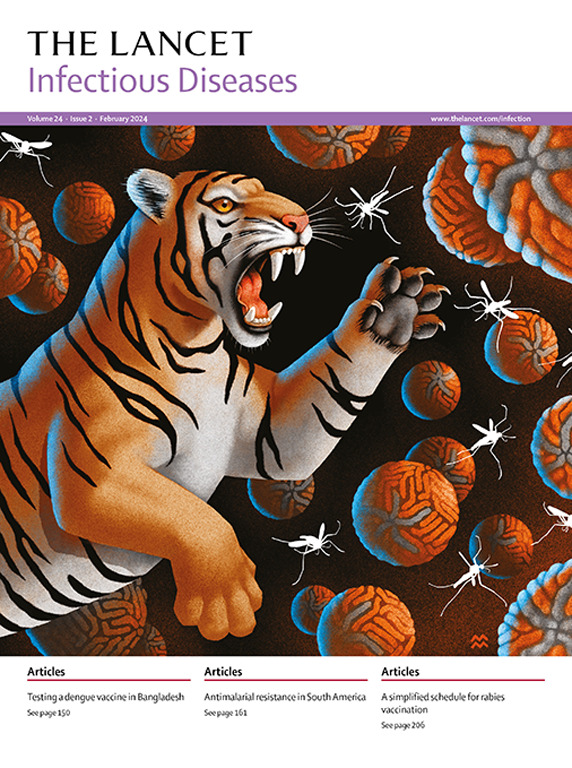Adjunctive ivermectin mass drug administration for malaria control on the Bijagos Archipelago of Guinea-Bissau (MATAMAL): a quadruple-blinded, cluster-randomised, placebo-controlled trial
IF 36.4
1区 医学
Q1 INFECTIOUS DISEASES
引用次数: 0
Abstract
Background
Arthropod vectors feeding on the blood of individuals treated with ivermectin have substantially increased mortality. Whether this effect will translate into a useful tool for reducing malaria burden at scale is not clear. Our trial aimed to assess whether using ivermectin as an adjunct to mass drug administration (MDA) with dihydroartemisinin–piperaquine would further reduce malaria prevalence.Methods
MATAMAL was a quadruple-blinded, cluster-randomised, placebo-controlled trial, conducted on the Bijagos Archipelago, Guinea-Bissau, an area of seasonal malaria transmission. All residents were invited to participate, with exclusions for drug safety. 24 clusters were randomised in a 1:1 ratio, using restriction randomisation, to either MDA with three daily oral doses of dihydroartemisinin–piperaquine and ivermectin (300 μg/kg per day) in three sequential months during the transmission season in 2021 and 2022, or MDA with dihydroartemisinin–piperaquine and placebo in the same schedule. The primary outcome was quantitative PCR prevalence of Plasmodium falciparum parasitaemia in all age groups, during peak transmission, after the second year of intervention. The primary entomological outcome was anopheline parity rate. The trial is registered with ClinicalTrials.gov (NCT04844905).Findings
Participants were recruited between June 7, 2021 and Sept 21, 2022. The baseline population was 25 882 (12 634 [50·6%] were female individuals and 12 317 [49·4%] were male individuals): 13 832 were in the intervention group and 12 050 in the control group. Cluster-level coverage for dihydroartemisinin–piperaquine ranged from 60·4% to 78·7%, and for ivermectin or ivermectin–placebo from 58·1 to 77·1%. Following the intervention, the prevalence of P falciparum infection was 118 (5·05%) of 2300 in the control group and 141 (6·64%) of 2083 in the intervention group. The adjusted risk difference was 1·67% (95% CI –1·44 to 4·78; p=0·28). There were 124 adverse events in the control group (1·0% of participants) and 267 in the intervention group (1·9% of participants). Two serious adverse events were reported, neither related to the intervention, and no treatment-related deaths. The anopheline parity rate was 1679 (67·8%) of 2475 in control clusters and 1740 (72·3%) of 2414 in intervention clusters. The adjusted risk difference was –1·32 (95% CI –14·77 to 12·12; p=0·84).Interpretation
Adding ivermectin to dihydroartemisinin–piperaquine MDA had no additional effect on reducing malaria prevalence or vector parity in this setting. The intervention was well tolerated. To our knowledge, this trial is the first to be designed to assess whether ivermectin has an additive effect on malaria when coadministered with dihydroartemisinin–piperaquine MDA.Funding
The National Institute for Health and Care Research, Medical Research Council, Wellcome, and Foreign, Commonwealth & Development Office.在几内亚比绍比热戈斯群岛(MATAMAL)大规模使用伊维菌素辅助控制疟疾:四重盲法、分组随机、安慰剂对照试验
背景以伊维菌素治疗过的人的血液为生的节肢动物病媒的死亡率大幅上升。目前尚不清楚这种效果能否转化为大规模减少疟疾负担的有用工具。我们的试验旨在评估使用伊维菌素作为双氢青蒿素-哌喹大规模用药(MDA)的辅助手段是否会进一步降低疟疾流行率。方法MATAMAL是一项四重盲法、分组随机、安慰剂对照试验,在几内亚比绍比热戈斯群岛进行,该地区是疟疾季节性传播区。所有居民均受邀参加,但出于药物安全考虑,不在试验范围内。24 个群组按 1:1 的比例随机分配,采用限制性随机法,在 2021 年和 2022 年传播季节的连续三个月内,接受每日口服三次双氢青蒿素-哌喹和伊维菌素(每天 300 μg/kg)的 MDA,或接受同样时间段内口服双氢青蒿素-哌喹和安慰剂的 MDA。主要结果是干预第二年后传播高峰期各年龄组恶性疟原虫寄生虫血症的定量 PCR 感染率。昆虫学方面的主要结果是疟原虫奇偶率。该试验已在 ClinicalTrials.gov 上注册(NCT04844905)。研究结果参与者于 2021 年 6 月 7 日至 2022 年 9 月 21 日期间招募。基线人群为 25 882 人(其中女性 12 634 人[50-6%],男性 12 317 人[49-4%]):干预组为 13 832 人,对照组为 12 050 人。双氢青蒿素-哌喹的群组覆盖率从 60-4% 到 78-7%不等,伊维菌素或伊维菌素-安慰剂的群组覆盖率从 58-1% 到 77-1%不等。干预后,对照组 2300 人中恶性疟原虫感染率为 118(5-05%)人,干预组 2083 人中恶性疟原虫感染率为 141(6-64%)人。调整后的风险差异为 1-67%(95% CI -1-44 至 4-78;P=0-28)。对照组有 124 例不良事件(占参与者的 1-0%),干预组有 267 例(占参与者的 1-9%)。报告了两起严重不良事件,均与干预无关,没有与治疗相关的死亡病例。对照组 2475 人中有 1679 人(67-8%)感染了疟原虫,干预组 2414 人中有 1740 人(72-3%)感染了疟原虫。在这种情况下,在双氢青蒿素-哌喹 MDA 的基础上添加伊维菌素对降低疟疾流行率或病媒奇偶性没有额外效果。干预措施的耐受性良好。据我们所知,该试验是首个旨在评估伊维菌素与双氢青蒿素-哌啶MDA联合应用时是否对疟疾有额外效果的试验。
本文章由计算机程序翻译,如有差异,请以英文原文为准。
求助全文
约1分钟内获得全文
求助全文
来源期刊

Lancet Infectious Diseases
医学-传染病学
CiteScore
60.90
自引率
0.70%
发文量
1064
审稿时长
6-12 weeks
期刊介绍:
The Lancet Infectious Diseases was launched in August, 2001, and is a lively monthly journal of original research, review, opinion, and news covering international issues relevant to clinical infectious diseases specialists worldwide.The infectious diseases journal aims to be a world-leading publication, featuring original research that advocates change or sheds light on clinical practices related to infectious diseases. The journal prioritizes articles with the potential to impact clinical practice or influence perspectives. Content covers a wide range of topics, including anti-infective therapy and immunization, bacterial, viral, fungal, and parasitic infections, emerging infectious diseases, HIV/AIDS, malaria, tuberculosis, mycobacterial infections, infection control, infectious diseases epidemiology, neglected tropical diseases, and travel medicine. Informative reviews on any subject linked to infectious diseases and human health are also welcomed.
 求助内容:
求助内容: 应助结果提醒方式:
应助结果提醒方式:


